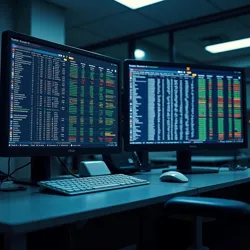Visual Space Swaps
 A specialized terminal displaying active visual space swap contracts and real-time arbitrage opportunities
A specialized terminal displaying active visual space swap contracts and real-time arbitrage opportunitiesVisual Space Swaps represent a sophisticated financial instrument within the attention economy that enables traders and corporations to exchange rights to different visual territories across varying temporal and spatial dimensions. Developed in 2037 by the Global Visual Exchange (GVX), these derivative contracts have become fundamental tools for managing risk and optimizing visual attention portfolios in the increasingly complex landscape of Visual Territory Futures trading.
Fundamental Mechanics
At their core, Visual Space Swaps operate on the principle of comparative attention value exchange. Two parties agree to trade the rights to different visual territories for specified periods, with the contract terms accounting for variations in attention quality, temporal positioning, and neurometric engagement potential. These sophisticated arrangements build upon traditional Attention Derivatives while incorporating advanced metrics from the Neurometric Valuation Standards.
The most common form of Visual Space Swap involves the exchange of prime-time urban display rights for extended-duration peripheral spaces. For example, a corporation might swap the rights to a premium downtown holographic projection zone during peak hours for rights to multiple suburban attention surfaces over a longer timeframe. This allows organizations to optimize their attention capture strategies while managing cost and exposure risks.
Technical Implementation
The execution of Visual Space Swaps relies on advanced computational systems that can accurately assess and compare the relative values of different attention spaces across multiple dimensions. The Atmospheric Commerce Institute maintains a network of neural monitoring stations that provide real-time data on attention flow patterns, enabling precise valuation of different visual territories.
These systems employ sophisticated algorithms developed by the Predictive Attention Sciences Institute to calculate swap ratios based on factors including demographic exposure, attention density, neural engagement quality, and temporal persistence. The introduction of Neural Flux Compensation technology in 2040 significantly improved the accuracy of these calculations by accounting for variations in collective consciousness patterns.
 Advanced neural flux measurement equipment used to calculate precise swap ratios
Advanced neural flux measurement equipment used to calculate precise swap ratiosMarket Structure
Visual Space Swaps are primarily traded through specialized exchanges that operate alongside traditional visual territory markets. The largest of these, the International Space Swap Exchange (ISSE), processes over 50,000 swap contracts daily, representing billions in attention value. The market's structure incorporates elements from both traditional financial exchanges and newer Attention Space Arbitrage platforms.
Trading in Visual Space Swaps requires specialized expertise in both attention economics and neurological engagement patterns. Professional swap traders, known as Attention Arbitrageurs, utilize advanced neural interface systems to simultaneously evaluate multiple swap opportunities across different temporal and spatial dimensions. The emergence of Temporal Arbitrage Intelligence has further revolutionized how these complex transactions are analyzed and executed.
Risk Management
The inherent complexity of Visual Space Swaps has led to the development of sophisticated risk management tools and protocols. The Visual Futures Trading Act requires all swap participants to maintain neural liability reserves proportional to their total swap exposure. These reserves are managed through specialized Neural Escrow Systems that can automatically execute compensatory attention transfers in case of contract defaults.
Major financial institutions have developed specialized insurance products to protect against swap-related losses. These instruments, known as Attention Default Swaps, provide protection against unexpected changes in attention patterns or technological disruptions that might affect the value of swapped visual territories.
Regulatory Framework
The regulation of Visual Space Swaps falls under the joint jurisdiction of the Global Attention Rights Commission and regional attention management authorities. The regulatory framework focuses on preventing attention monopolies, ensuring market stability, and protecting public visual commons from excessive commercialization.
Key regulations include mandatory neural impact assessments for large-scale swaps, restrictions on the concentration of prime attention spaces, and requirements for maintaining minimum levels of public access to essential visual territories. The Visual Commons Protection Act establishes specific guidelines for how swapped spaces must preserve certain fundamental rights to unmediated visual experience.
Social and Economic Impact
The proliferation of Visual Space Swaps has fundamentally altered how organizations approach attention resource management. Educational institutions regularly engage in swap markets to optimize their access to student attention spans, while healthcare providers use swaps to ensure priority access to critical visual territories during emergency situations.
The market has also given rise to new forms of social organization, including Attention Cooperatives that collectively manage and trade visual rights for community benefit. These organizations often use swap contracts to ensure equitable distribution of valuable attention spaces among their members while maximizing overall community returns.
Future Developments
Industry analysts predict continued evolution in the Visual Space Swap market as new technologies create novel forms of tradeable attention space. The development of Biophotonic Integration systems is expected to enable more granular trading of neural engagement rights, while advances in quantum attention entanglement may create opportunities for simultaneous multi-dimensional swaps.
Research into Synaptic Value Transfer protocols promises to enable direct neural-to-neural swaps without the need for intermediate visual manifestation, potentially revolutionizing how attention resources are traded and managed. These developments could fundamentally reshape the nature of attention commerce while raising new questions about cognitive autonomy and consciousness rights.
See Also
- Attention Derivatives
- Visual Territory Futures
- Neural Flux Compensation
- Temporal Arbitrage Intelligence
- Attention Default Swaps
References
- Global Visual Exchange Annual Report on Swap Markets (2042)
- Journal of Neural Economics, Volume 15: "The Evolution of Attention Trading"
- International Space Swap Exchange Trading Guidelines
- Visual Commons Protection Act Technical Documentation